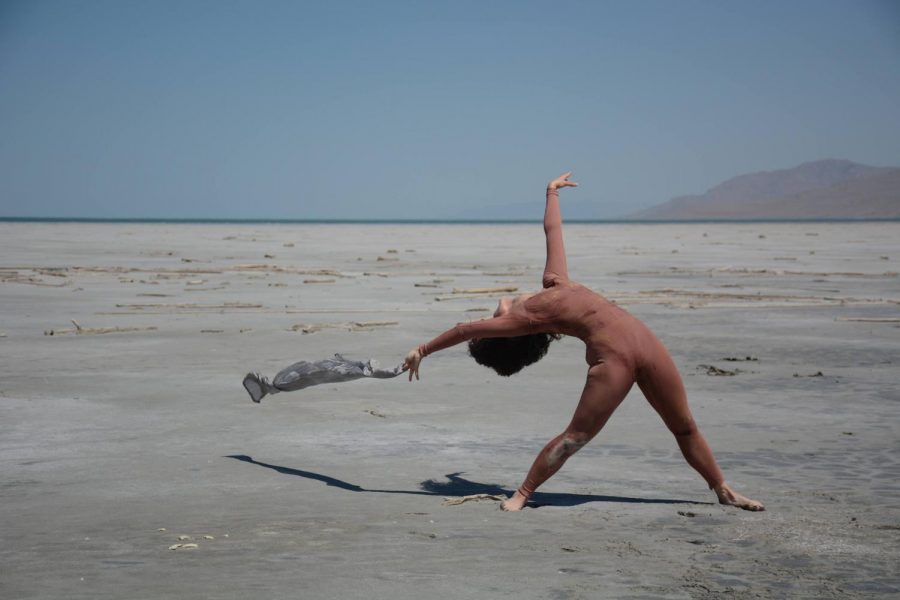Artist of the Week: Jessica Baynes
Baynes Dances through the Pain and Shares Movement as a Source of Healing
After Jessica Baynes suffered from a traumatic brain injury, she used her recovery to enhance, not hinder, her work. (Photo by Scotty Hardwire | Courtesy Jessica Baynes)
February 13, 2020
When Jessica Baynes was a freshman in the University of Utah Modern Dance Program, she suffered a traumatic brain injury when she fell out of a leap and landed on the back of her skull. Unbeknownst to her at the time, her experience with the relationship between recovery and movement would launch her into a position to aid others in their own healing from neurological injuries.
The Road to Recovery
Baynes, after months of experiencing illness, forgetfulness and balance problems after her fall, was diagnosed with post-concussion syndrome. She began to visit a neurological physical therapist several times a week to combat the effects, especially the loss of balance. “We started treatment solely by practicing how to move my eyes from left to right without getting nauseous. Then, moving my eyes evolved into shifting my head without getting nauseous. Head movements graduated to upper body movements, upper body movements evolved into whole body movements,” Baynes said.
Many dancers or athletes who experience sustaining and life-changing injuries like Baynes did are often met with isolation from their peers, the stigmatization of their healing and a loss of identity in their craft. Despite her diligent efforts in retraining her brain and body, Baynes was told to give up dancing and the notion of creating a career out of it. “Being advised to change career paths was a distressing and difficult pill to swallow. So, truthfully, I rejected it,” Baynes said. “The anxiety, ironically, ignited my desire to contribute to the field without the conventional use of my body. I felt the need to prove to myself that one injury was not going to prevent me from engaging in what I love to do.”
That love for dance and movement, in all of its many forms, was ignited in Baynes when she was very young. “My father was an immigrant from Ireland whose professional career was playing Celtic guitar, and I was always kind of a wiggly kid, so Irish dancing was the perfect way for me to channel my love for rhythm and movement. I continued studying Irish dance and Flamenco for about 12 years until I enrolled at San Diego School of Creative and Performing Arts at 15 years old,” Baynes said.
Healing in Modern Dance

After the long journey that Baynes had been on with dance, not giving up only followed. After graduating with her BFA, Baynes founded Healing in Motion Dance, a program designed to aid those who have suffered from neurological illnesses by incorporating ballet into their physical therapy. Inspired by the work of a professor, Baynes realized the benefits of a dance class setting for patients, creating “a movement environment where participants of all levels and varieties of physical abilities have an equal opportunity to contribute.”
Baynes hears about skepticism from combining dance and physical therapy. “In the context of Healing in Motion Dance, there has been little dispute about its holistic benefits. With regard to ballet and dance in general, however, I encounter confusion and skepticism all the time. ‘How could you major in something like that? How is that important or beneficial?’” However, as a truly elegant storyteller and passionate artist, Baynes spins any comment flung her way on its head.
“What critical information missing is that playful movement is fundamental to the human condition. Children skip and jump shamelessly in public, and it is society which teaches them to unlearn their natural state of creative physical play in order to practice prioritizing their minds over their bodies,” Baynes said. “The implication with this is that either the body or the mind must be sedated for the other to be optimized. I have decided to dedicate my time and studies to help people relearn the joy of moving and existing in their bodies, and how to strengthen their mind-body connection. Is that not important or beneficial?”
Her tremendous work on Healing in Motion Dance was recently recognized when she presented at the TedxSaltLakeCity event on “Dynamic Harmony” this past September. Featuring firsthand accounts of her own recovery, testimonials of patients in her classes that would have never dreamed of taking ballet classes and a final photo of their production of Swan Lake, Baynes’ storytelling was incredibly moving. “I truly feel honored to have a platform to share these moving and often unheard narratives,” Baynes said. “I definitely feel a personal sense of pressure to ensure that I deliver their accounts in a way that is always honest.”
Baynes carries this incredible perspective towards the world that encompasses not only her love for her craft, but also her respect for anyone daring to enter the vulnerable and transformative space that movement provides. Intentional and thoughtful, her reflections on the Herculean journey that dance has taken her on are beautiful.
Baynes said, “I am still coming to terms with the dramatic shift that my path has taken as a result of the injury four years ago. I reflect on the circumstances with gratitude because there are a lot of creative possibilities which have emerged as a result of my journey taking an unexpected ‘hit.’ I have found a tremendous sense of purpose from using my skill set in dance to effectively share the joy of movement with others.”








